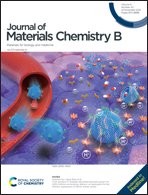Rational design of an HClO-specific triggered self-immolative fluorescent turn-on sensor and its bioimaging applications†
Abstract
The development of a rapid and intuitive method for the detection of a specific small molecule biomarker is important for understanding the pathogenesis of relevant diseases. Described here is the design and evaluation of an HClO-specific triggered self-immolative fluorescent sensor (RESClO) based on the structure of an N-protected Resorufin dye. Due to the interrupted π-conjugated structure of the Resorufin dye, the free sensor showed very weak absorption and fluorescence. It can quickly complete the response to HClO (within 10 s) with high selectivity and sensitivity (LOD = 16.8 nM) in aqueous solution. The sensor can be made into test strips to quickly detect HClO in the environment by obvious changes in color and fluorescence. It was successfully used for bioimaging of exogenous and endogenous HClO in cells and zebra fish. More importantly, it can also be used for visual imaging of mouse arthritis models. Thus, sensor RESClO can provide a simple and promising visual analytical tool for the detection of HClO in the environment and the early diagnosis of HClO-mediated related diseases.



 Please wait while we load your content...
Please wait while we load your content...